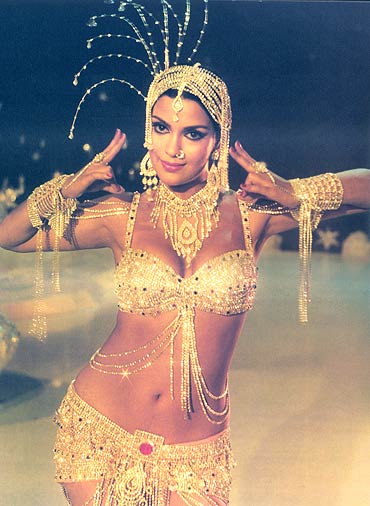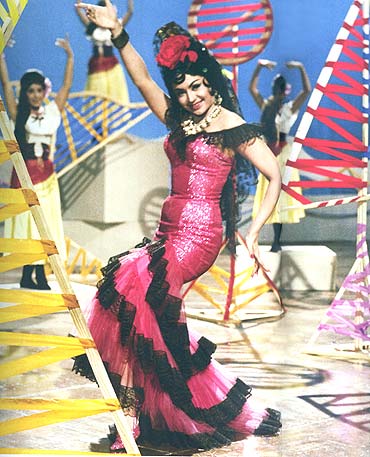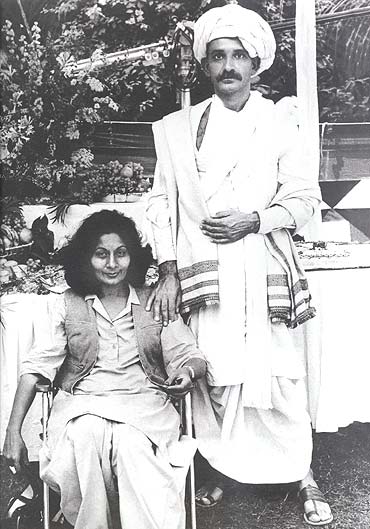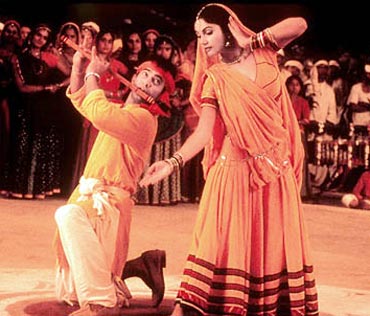 | « Back to article | Print this article |
The Best Bollywood costumes, right here
Some of the biggest movies in Hindi cinema -- like Gandhi, Lekin, Guide, Mera Naam Joker, Ganga Jamuna, Lagaan, Jodha Akbar and Swades -- owe their exquisite costumes to Bhanu Athaiya.
An Oscar winner for her work in Gandhi, Bhanu Athaiya has been designing costumes since 1953.
Some of her greatest works have been captured in her autobiography, Bhanu Rajopadhye Athaiya The Art of Costume Design. We bring you some fascinating excerpts, where Athaiya describes her movie experiences.
Satyam Shivam Sundaram (1978)
One of my most challenging assignments was Raj Kapoor's fantasy, Satyam Shivam Sundaram. The film starred the beautiful, shapely and stunning Zeenat Aman and Raj Kapoor's younger brother, the dashingly handsome Shashi Kapoor.
Zeenat played the role of the daughter of a local temple priest and was required to wear village attire, as well as don elaborate and gorgeous outfits for the fantasy sequences. The script demanded that she constantly kept one side of her face hidden, since it was meant to be heavily scarred. Her paramour, a young city-bred man who had only caught a few glimpses of her, fantasized what she could look like. In his imagination, she wore a number of exquisite garments which displayed her shapely figure and enhanced her radiant beauty.
It was a great challenge for me to move between two contrasting personae of the heroine -- one of a starkly simple village girl, and the other of an apsara-like vision of beauty. The varied costumes did full justice to both the characterizations.
Excerpted from Bhanu Rajopadhye Athaiya The Art of Costume Design, by Bhanu Athaiya, HarperCollins India, with the publisher's permission, Rs 2995.
Chaudhvin Ka Chand (1960)
The Muslim social drama was based on the Uttar Pradesh nawabi culture of a bygone era. I did my homework by meeting several people from that state, who were steeped in the tradition in spite of living in Bombay. They spoke Urdu and had an extremely refined etiquette. One could also find expert embroidery tailors from Uttar Pradesh quite easily in Bombay.
During those days I was very excited to work on this film. I had worked with Waheedaji before, and I also designed the costumes of Minoo Mumtaz, who played the coquettish courtesan.
My first impression of Guru Dutt was that he was a soft-spoken man of few words. He briefly explained the job he had in mind for me and I got what he had to convey quite clearly. We understood each other right away.
Teesri Manzil (1966)
Helen has been the most nimble footed and graceful western dancer of Hindi commercial cinema. She was the only artiste who could pull off sizzling cabaret sequences with complete confidence and ease. She always looked fetching in cabaret costumes.
Invariably, she would wear fitting bodies to show off her slim waistline, and her long limbs would be draped in stockings and her arms covered in long gloves. This was typical of the vamp's costume of those times. Helen's characters were mischievous, but never 'immoral' and that is what endeared her to the audiences.
I have created many western cabaret costumes for Helen, however, this Spanish costume from the song 'O haseena zulfonwali' is my favourite. Helen is seen wearing a fully sequined flaming red dress trimmed with black net frill. It brings out the seductive movements of the Spanish dance to perfection.
Gandhi (1982)
The stark look of Gandhi's dhoti was frightening in comparison to the razzle-dazzle of Hindi cinema. Simi shook me and said, 'This is an important assignment and a great opportunity to show your talent! I am fixing an appointment for you to meet the director. Carry your biodata and wear nice clothes. Both of you will have a lot to talk about.'
The audition was held at the Sea Rock Hotel at Bandra in Bombay where Lord Richard Attenborough's production office was located. Richard looked at my biodata and we chatted for around 15 minutes, so that he could get an idea about my understanding of India. At the end of it, he informed his team that he had found his costume designer for Gandhi. He then gave me the script and asked me to meet him the following day to discuss it. What a script it was! It brought tears to my eyes.
The next day, Richard told me to join the team at the Ashoka Hotel in Delhi from the first of September. I told him that I had a few assignments on hand and required some time to free myself. 'Don't worry darling, we will find a way out,' he said in his characteristic simple style.
I had to be prepared in just three months. Covering a span of half a century, with so many events, incidents and changes in time and style, was not easy. The looks of the principal characters had to undergo constant change with age, as the story progressed. I worked day and night, like a person possessed, to meet the deadline. I would comb the museums and libraries in Delhi to gather all my reference material.
Ben had been told that I had the best reference material and then requested me to prepare a wall full of Gandhi pictures from my collection so that he could draw inspiration from them. He also asked me to introduce him to the basic philosophy of Gandhi's simple attire of the dhoti and shawl.
Lagaan (2001)
Ashutosh Gowariker, the director of Lagaan, came to meet me at my workshop at Breach Candy one day, along with the producer, Reena Datta. He introduced himself by saying that his father had studied with my eldest sister at Kolhapur's Rajaram College. Ashutosh had brought along with the complete script of his film and said that he would like me to read it. The storyline was inspiring and offered me plenty of scope as a designer.
In India it is a luxury for a costume designer to get a complete script before hand. I appreciated the gesture and made the best of it. I had three months, from the time of reading the script to the time of actual execution of the costumes. I conceived and executed the entire look for this film, from the villagers of Champaner, to the British regiment and the group of English civilians. There were a number of interesting requirements, ranging from the cricket costumes and gear, the British military uniforms and dashing red jackets for the ball, to the ladies' graceful evening gowns, as well as the village dresses.
All the costumes were executed in Bombay itself but I was taken to the location to get a feel of the place. The entire film was shot on location in Bhuj, Gujarat, but the story was supposed to take place in the dusty plains of Madhya Pradesh. I created the entire wardrobe for the villagers with handlooms and khadi and did not touch mill fabrics. I visualized the British uniform in khaki, exploring the type of regiment it would belong to and the medals and decorations that could have been worn. In India, such outfits cannot be hired or purchased off the rack. Each one had to be created after deep study of the look of that period.
For the British ladies, I chose pale pastel colours to contrast with the bright Indian colours. The entire English wardrobe was created with voiles, using pin tucks and laces that were typical of the gowns of that period. This was not something that Indian tailors were used to making. I had to devote nearly a month's time working with them, so that they executed it correctly, with the right proportions.




